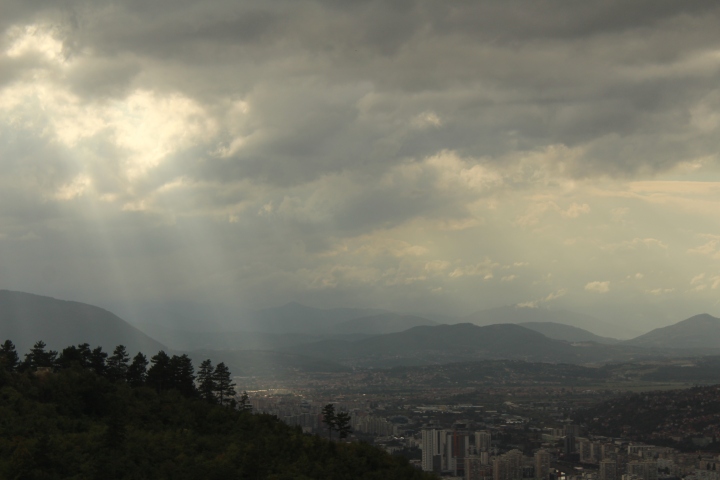Sarajevo is famous for all the wrong reasons. The place where Franz Ferdinand was shot, sparking World War One. The place that was besieged in the Bosnian war. Not what any city’s tourism board really wants. But what we found was a city full of life, optimism, and some of the most welcoming people you’re likely to meet.
After checking into our Airbnb, and getting our bearings in the city, we signed up to a ‘Sarajevo during the Siege’ tour, which turned out to be the perfect way of understanding what life was like in the city during the war. Our tour guide, Enes, was a child during the siege, and recounted stories of life in the city. He told us about a time when, while playing football in the street with his friends, one of his friends was shot in the leg by a sniper nestled in the hills above the city. Talking to someone who experienced the war first-hand made it all very real, and as we rattled around the streets of Sarajevo in a minibus, Enes casually pointed out hotels that were shelled, a market where there was a massacre, and building that were still covered in bullet holes.
We came to the edge of the city and headed up Mount Trebević. The mountain has seen a lot in the last 35 years. When Sarajevo hosted the 1984 Winter Olympics, it was the location for downhill skiing, bobsledding, luge and the sekelton. A few years later the same mountain became a snipers’ nest, with thousands of Serbian troops shooting men, women and children as they hurried between the tower blocks in the city below.
As the minibus struggled up the steep roads, we caught glimpses of the city through the trees, and could see concrete bunkers from where weapons had been trained on the people below. It should have been a more sombre moment, but the driver of the minibus was blasting out ‘Cheerleader’ on repeat at full blast through the stereo, which true to its name, did cheer things up considerably.

We reached the top of the mountain and walked towards the beginning of the abandoned bobsleigh track. It was an odd feeling as we walked along the pathway, knowing that in the trees around us, mere feet away, lay thousands of unexploded mines. Although most of the mines have now been cleared, many remain to this day. The bobsleigh run itself was used as a shooting range and a sniper point during the siege, visible today in the bullet holes peppered across the concrete and foam insulation of the track.

After descending the mountain, we went out in search of some dinner, and opted for a local fast food tradition, burek. This is a filo pastry-style layered cheese pie, covered in sour cream and served by the gram. Not knowing how much was a sensible amount; I ordered half a kilo, whole Nicola went for a more sensible 300g. We sat on a table on the cobbled street, watching the evening crowds go past, realising we’d ordered enough for a large family. For almost a kilogram of pie and drinks it came to about £2. And as we’d eaten so much, we didn’t have to eat again for another two weeks, so it was extremely good value.

You’re right that Sarajevo is a wonderful town and famous for all the wrong reasons.
LikeLike
Hopefully it won’t be long before they get the winter sports tourism up and running, and it can once again be in the headlines for the right reasons!
LikeLiked by 1 person
This is the spirit well captured. Your account made me smile despite myself and the grim history. I know the people, I’m Slovenian, and that’s how they are, optimistic and jolly no matter what. I have a plan to visit the city with my Italian amore one of these summers. Not sure if I’ll take the tour but eat? YEEES. 🙂
LikeLike
Hi Manja! Thanks for visiting, and I’m pleased you like it! Definitely get as much food as you can – it’s brilliant!
Gavin
LikeLiked by 1 person
We did a tour with a guide who’d lived through the siege as well. Fascinating and vibrant city.
LikeLike
It really is – I want to go back every couple of years to see how it’s changing.
Gavin
LikeLiked by 1 person